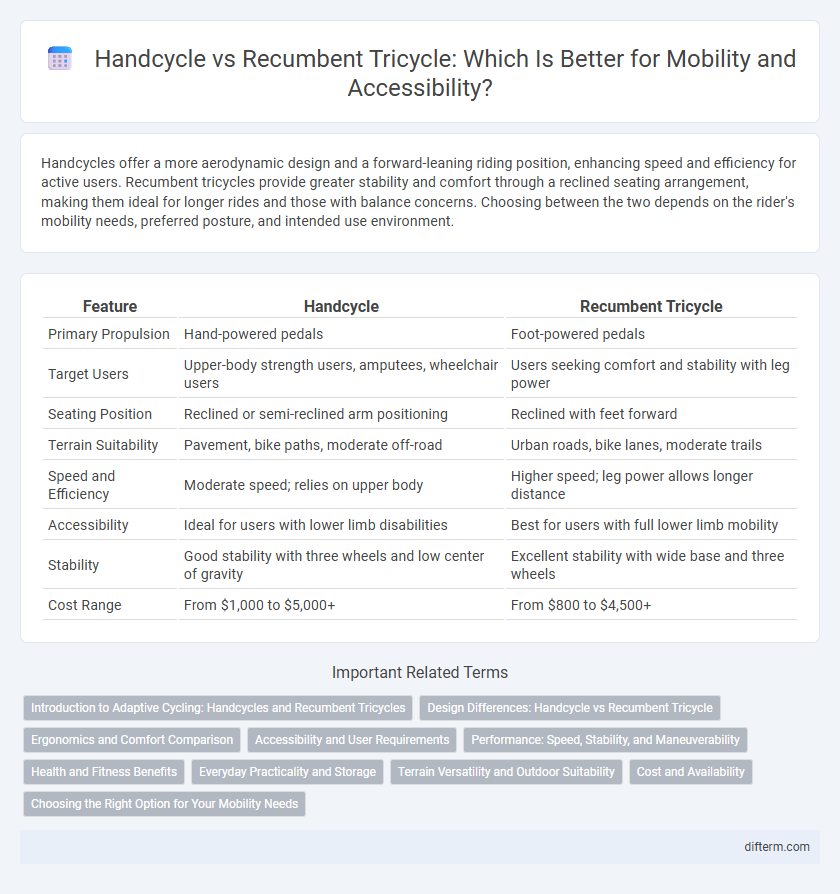Handcycles offer a more aerodynamic design and a forward-leaning riding position, enhancing speed and efficiency for active users. Recumbent tricycles provide greater stability and comfort through a reclined seating arrangement, making them ideal for longer rides and those with balance concerns. Choosing between the two depends on the rider's mobility needs, preferred posture, and intended use environment.
Table of Comparison
| Feature | Handcycle | Recumbent Tricycle |
|---|---|---|
| Primary Propulsion | Hand-powered pedals | Foot-powered pedals |
| Target Users | Upper-body strength users, amputees, wheelchair users | Users seeking comfort and stability with leg power |
| Seating Position | Reclined or semi-reclined arm positioning | Reclined with feet forward |
| Terrain Suitability | Pavement, bike paths, moderate off-road | Urban roads, bike lanes, moderate trails |
| Speed and Efficiency | Moderate speed; relies on upper body | Higher speed; leg power allows longer distance |
| Accessibility | Ideal for users with lower limb disabilities | Best for users with full lower limb mobility |
| Stability | Good stability with three wheels and low center of gravity | Excellent stability with wide base and three wheels |
| Cost Range | From $1,000 to $5,000+ | From $800 to $4,500+ |
Introduction to Adaptive Cycling: Handcycles and Recumbent Tricycles
Handcycles and recumbent tricycles provide versatile adaptive cycling options designed to enhance mobility for individuals with varying physical abilities. Handcycles utilize upper body strength through hand pedals, promoting cardiovascular fitness and upper limb coordination, while recumbent tricycles offer a stable riding position with ergonomic seating that reduces strain on the back and joints. Both adaptive cycles improve accessibility, allowing users to engage in outdoor exercise, rehabilitation, and recreational activities with increased independence and comfort.
Design Differences: Handcycle vs Recumbent Tricycle
Handcycles feature a forward-leaning design with hand-powered cranks positioned at the front, offering enhanced upper body engagement and maneuverability. Recumbent tricycles have a reclined seating position with pedals located at the front or mid-frame, prioritizing comfort and stability. The handcycle's ergonomic setup maximizes propulsion efficiency, while the recumbent tricycle emphasizes user support and balanced weight distribution.
Ergonomics and Comfort Comparison
Handcycles offer superior upper body engagement and customizable seating angles, promoting effective muscle use and reducing shoulder strain. Recumbent tricycles feature a low seat and backrest that provide enhanced lumbar support and distribute weight evenly, minimizing pressure points during extended rides. Ergonomic design in handcycles prioritizes arm reach and crank positioning while recumbent tricycles excel in leg comfort and stability for users with lower-body mobility challenges.
Accessibility and User Requirements
Handcycles offer enhanced accessibility for users with limited upper body strength due to adjustable seating and crank positions tailored to individual needs. Recumbent tricycles provide greater stability and comfort for individuals requiring full-body support, facilitating longer rides and improved balance. User requirements such as terrain type, physical ability, and control preferences critically determine the optimal choice between these mobility devices.
Performance: Speed, Stability, and Maneuverability
Handcycles generally offer superior speed and aerodynamic efficiency due to their streamlined design and arm-powered propulsion, making them ideal for performance-oriented users. Recumbent tricycles provide enhanced stability with their three-wheel configuration and low center of gravity, ensuring safer rides on uneven terrains. However, handcycles typically excel in maneuverability with tighter turning radii, while recumbent tricycles prioritize comfort and balance over sharp turns.
Health and Fitness Benefits
Handcycles provide a robust cardiovascular workout by engaging the upper body muscles intensely, enhancing arm strength and endurance. Recumbent tricycles offer low-impact exercise that reduces joint strain while promoting lower body muscle toning and improved balance. Both mobility devices contribute significantly to improving overall fitness, but handcycles focus more on upper body health, whereas recumbent tricycles support whole-body rehabilitation and stability.
Everyday Practicality and Storage
Handcycles offer compact designs that enhance everyday practicality by allowing easier maneuverability in tight urban spaces and simple folding mechanisms for convenient storage. Recumbent tricycles provide stable seating and increased comfort but often require more storage space due to their larger frame size and bulkier structure. For daily use, handcycles are typically preferred for their portability, while recumbent tricycles excel in stability during longer rides but demand dedicated storage solutions.
Terrain Versatility and Outdoor Suitability
Handcycles offer superior terrain versatility thanks to their lightweight design and agile handling, making them ideal for varied outdoor environments including paved roads, gravel trails, and mild off-road conditions. Recumbent tricycles provide enhanced stability and comfort on flat, paved surfaces but may struggle on uneven or rugged terrain due to their wider frame and lower ground clearance. Outdoor suitability favors handcycles for users seeking adaptable mobility across diverse landscapes, while recumbent tricycles better serve those prioritizing comfort on smoother routes.
Cost and Availability
Handcycles typically offer a lower initial cost compared to recumbent tricycles, making them more accessible for users seeking budget-friendly mobility options. Recumbent tricycles often come with advanced features and customization, which increases their price and may limit availability in some markets. Both types are available through specialized retailers and online platforms, but handcycles generally have a broader distribution network due to their simpler design and lower production costs.
Choosing the Right Option for Your Mobility Needs
Handcycles offer greater upper-body workout and compact design, making them ideal for active users seeking agility and cardiovascular benefits. Recumbent tricycles provide enhanced stability and comfort with a lower center of gravity, suitable for individuals requiring more support and longer rides. Selecting the right mobility device depends on factors such as terrain, physical strength, and balance requirements to ensure optimal safety and performance.
handcycle vs recumbent tricycle Infographic

 difterm.com
difterm.com